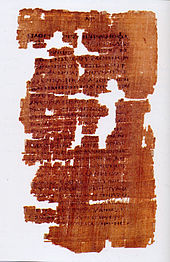
Barnabas, born Joseph (Ἰωσήφ) or Joses (Ἰωσής), was according to tradition an early Christian, one of the prominent Christian disciples in Jerusalem. According to Acts 4:36, Barnabas was a Cypriot Jew. Named an apostle in Acts 14:14, he and Paul the Apostle undertook missionary journeys together and defended Gentile converts against the Judaizers. They traveled together making more converts, and participated in the Council of Jerusalem. Barnabas and Paul successfully evangelized among the "God-fearing" Gentiles who attended synagogues in various Hellenized cities of Anatolia.

The Roman historian and senator Tacitus referred to Jesus, his execution by Pontius Pilate, and the existence of early Christians in Rome in his final work, Annals, book 15, chapter 44.

Joseph of Arimathea was, according to all four canonical gospels, the man who assumed responsibility for the burial of Jesus after Ηis crucifixion. The historical location of Arimathea is uncertain, although it has been identified with several towns. A number of stories that developed during the Middle Ages connect him with Glastonbury, England and also with the Holy Grail legend.
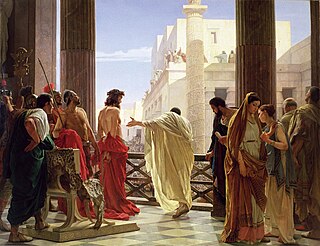
Pontius Pilate was the fifth governor of the Roman province of Judaea, serving under Emperor Tiberius from the year 26/27 to 36/37 AD. He is best known for being the official who presided over the trial of Jesus and later ordered his crucifixion. Pilate's importance in modern Christianity is underscored by his prominent place in both the Apostles' and Nicene Creeds. Due to the Gospels' portrayal of Pilate as reluctant to execute Jesus, the Ethiopian Church believes that Pilate became a Christian and venerates him as a martyr and saint, a belief historically shared by the Coptic Church.

In Christianity, the Passion is the short final period in the life of Jesus Christ.
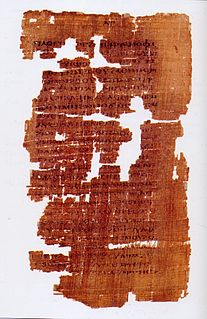
The Gospel of Peter, or the Gospel according to Peter, is an ancient text concerning Jesus Christ, only partially known today. It is considered a non-canonical gospel and was rejected as apocryphal by the Church's synods of Carthage and Rome, which established the New Testament canon. It was the first of the non-canonical gospels to be rediscovered, preserved in the dry sands of Egypt.

The Gospel of Mary is a non-canonical text discovered in 1896 in a 5th-century papyrus codex written in Sahidic Coptic. This Berlin Codex was purchased in Cairo by German diplomat Carl Reinhardt.
The Decretum Gelasianum or the Gelasian Decree is so named because it was traditionally thought to be a Decretal of the prolific Pope Gelasius I, bishop of Rome 492–496. The work reached its final form in a five-chapter text written by an anonymous scholar between 519 and 553, the second chapter of which is a list of books of Scripture presented as having been made Canonical by a Council of Rome under Pope Damasus I, bishop of Rome 366–383. This list, known as the Damasine List, represents the same canon as shown in the Council of Carthage Canon 24, 419 AD.
Pontius Pilate's wife is the unnamed spouse of Pontius Pilate, who appears only once in the Gospel of Matthew, where she intercedes with Pilate on Jesus' behalf. It is uncertain whether Pilate was actually married, although it is likely. In later tradition, she becomes known as Procula or Procla and plays a role in various New Testament Apocrypha. At a later date, she acquires the name Claudia Procula in Western tradition, as well as other names and variants of these names. She is venerated as a saint by the Eastern Orthodox Church, the Coptic Church, and the Ethiopian Church. She has also frequently been featured in literature and film.

The Apocalypse of Thomas is a work from the New Testament apocrypha, apparently composed originally in Greek. It concerns the end of the world, and appears to be a rendering of the Apocalypse of John, although written in a somewhat less enigmatic or mystical manner. It is the inspiration for the popular medieval millennial list Fifteen Signs before Doomsday.

The stolen body hypothesis posits that the body of Jesus Christ was stolen from his burial place. His tomb was found empty not because he was resurrected, but because the body had been hidden somewhere else by the apostles or unknown persons. Both the stolen body hypothesis and the debate over it presume the basic historicity of the gospel accounts of the tomb discovery. The stolen body hypothesis finds the idea that the body was not in the tomb plausible – such a claim could be checked if early Christians made it – but considers it more likely that early Christians had been misled into believing the resurrection by the theft of Jesus's body.
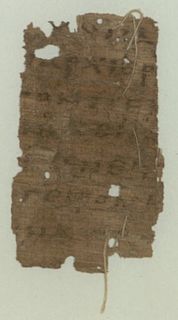
Matthew 27 is the 27th chapter in the Gospel of Matthew, part of the New Testament in the Christian Bible. This chapter contains Matthew's record of the day of the trial, crucifixion and burial of Jesus. Scottish theologian William Robertson Nicoll notes that "the record of this single day is very nearly one-ninth of the whole book".
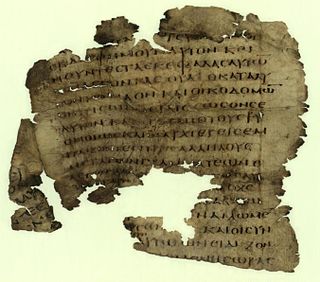
Mark 15 is the fifteenth chapter of the Gospel of Mark in the New Testament of the Christian Bible. This chapter records the narrative of Jesus' passion, including his trial before Pontius Pilate and then his crucifixion, death and entombment. Jesus' trial before Pilate and his crucifixion, death, and burial are also recorded in Matthew 27, Luke 23, and John 18:28–19:42.
Matthew 28:14 is the fourteenth verse of the twenty-eighth chapter of the Gospel of Matthew in the New Testament. This verse is part of the resurrection narrative. In this verse the priests of Jerusalem assured the safety of the tomb guards should the governor, Pontius Pilate, receive report of their failure.

Matthew 27:2 is the second verse of the twenty-seventh chapter of the twenty-seventh chapter of the Gospel of Matthew in the New Testament. Jesus has just seen condemned by the Jewish Sanhedrin, and in this verse is presented to Pontius Pilate.
Deicide is the killing of a god. The concept may be used for any act of killing a god, including a life-death-rebirth deity who is killed and then resurrected.

The Secret of the Kingdom is a 1959 novel by Finnish author Mika Waltari about the early days of Christianity. The story is told through the eyes of Marcus, a Roman citizen who arrives in Jerusalem on the day Jesus is crucified.

In the canonical gospels, Pilate's court refers to the trial of Jesus in praetorium before Pontius Pilate, preceded by the Sanhedrin Trial. In the Gospel of Luke, Pilate finds that Jesus, being from Galilee, belonged to Herod Antipas' jurisdiction, and so he decides to send Jesus to Herod. After questioning Jesus and receiving very few replies, Herod sees Jesus as no threat and returns him to Pilate.

Mary of Nazareth is a 2012 Italian-German-Spanish television movie directed by Giacomo Campiotti. It focuses on life events of Mary of Nazareth, Mother of Jesus, and Mary Magdalene.
The Gospels of the Passion are related to the last events of Jesus' life. The last chapters of the canonical gospels of gospel of Matthew, gospel of Mark, gospel of Luke and Gospel of John receive this classification.
